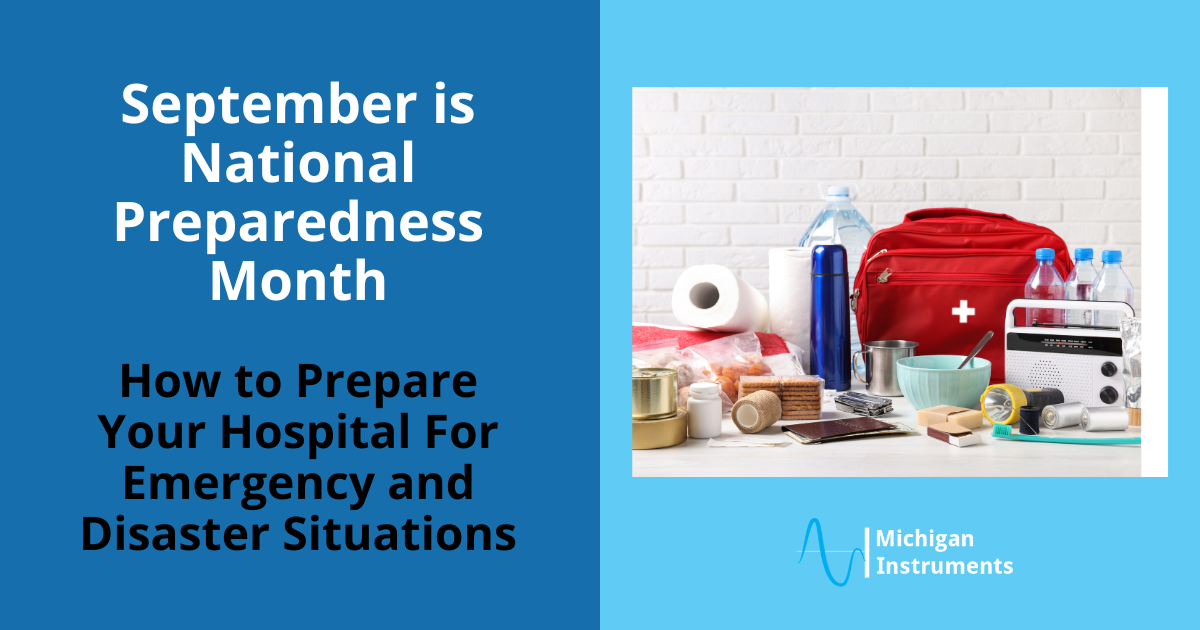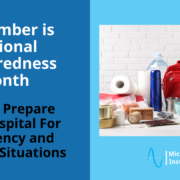
First launched by the Federal Emergency Management Agency (FEMA), National Preparedness Month occurs every September with the goal to raise awareness about the importance of being prepared for disasters and emergencies.
For hospitals, preparedness is not just a yearly observance, but an ongoing commitment to safeguarding the health and well-being of their patients, staff, and communities.
No one can predict when a disaster occurs or how severe the circumstances will be. However, you can take precaution by learning how to prepare your hospital to minimize danger. Keep reading to learn how.
The Importance of Hospital Preparedness
Hospitals are hubs of healthcare delivery, and their ability to function during emergencies can be a matter of life and death.
Whether it’s a natural disaster like a hurricane, a public health crisis like a pandemic, or a mass casualty event, hospitals must remain operational to meet the needs of their communities.
Here’s why hospital preparedness is crucial:
1. Lifesaving Care
Hospitals provide critical medical care, and during emergencies, the demand for healthcare services often surges. Prepared hospitals can continue to offer essential treatments, surgeries, and emergency care to those in need.
2. Community Resilience
Hospitals are an integral part of community resilience. When hospitals are prepared, they can help stabilize a situation, provide a safe haven for patients, and support recovery efforts.
3. Resource Conservation
Prepared hospitals can manage their resources more efficiently, ensuring that supplies, personnel, and equipment are available where and when needed. This helps prevent waste and ensures a sustainable response.
4. Maintaining Public Trust
During a crisis, people look to hospitals for help and guidance. A prepared hospital maintains public trust by demonstrating its ability to respond effectively, thereby reducing panic and uncertainty.
Key Steps to Hospital Preparedness in Emergency & Disaster Situations
1. Risk Assessment
Begin by conducting a thorough risk assessment to identify potential hazards and vulnerabilities specific to your hospital’s location. Consider factors like natural disasters, public health emergencies, and infrastructure vulnerabilities.
2. Emergency Plans and Policies
Develop comprehensive emergency plans and policies that address various scenarios. These should include evacuation plans, communication strategies, and guidelines for resource allocation.
3. Training and Education
Regularly train hospital staff in emergency response protocols. Ensure that everyone understands their roles and responsibilities during a crisis. Conduct drills and simulations to practice responses.
4. Resource Stockpiling
Stockpile essential medical supplies, including medications, personal protective equipment (PPE), and medical equipment. Maintain a robust inventory management system to monitor and rotate supplies regularly.
5. Communication Systems
Establish reliable communication systems, both within the hospital and with external partners such as local emergency management agencies, other healthcare facilities, and first responders.
6. Technology and Data Management
Leverage technology for real-time data monitoring and reporting. Electronic health records (EHRs) can help ensure patient information is accessible even during power outages.
7. Patient and Family Engagement
Educate patients and their families on what to expect during emergencies and how to prepare. Provide clear instructions for accessing care and information during a crisis.
8. Invest in Life-Saving Equipment
During an emergency, it can be difficult to manage stress and maintain the energy it takes to look after everyone around you. In these cases, smart medical devices can be your saving grace. Since September is National Preparedness Month, it’s the perfect time to begin preparing your hospital with such equipment.
We provide high quality medical devices that can assist your hospital staff in emergency scenarios. With quick, easy and stable chest placement and the ability to fit larger patients than other devices, our Life-Stat and Thumper CPR devices are lightweight and easy to use when patients are in cardiac arrest.
They offer many advantages in an emergency setting including easy and fast set-up, the option to include ventilation with chest compressions, and most importantly, hands-free operation. That way, your staff will have the ability to focus on other life-saving measures.
There’s a reason why so many healthcare facilities across the country (and the world) use our devices. They’re a tried and true, one-of-a-kind solution during emergency situations; they can help calm the situation and contribute to saving lives.
Our Automated CPR Devices Save Lives. Learn How.
Take the extra step toward 24/7 safety in your health care facility. Our devices allow medical professionals to concentrate on other life-saving procedures and provide improved access to the patient.
Learn more about our devices and all of the ways they can assist your healthcare staff.




